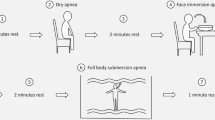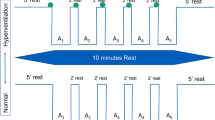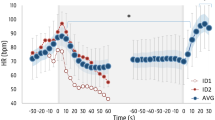Abstract
Purpose
Two potentially protective responses to apnea were studied in obstructive sleep apnea (OSA) patients; the diving response and the increase in Hb concentration [Hb] via spleen contraction.
Methods
Eight OSA patients and ten healthy controls performed apneas in air (A) and apneas with facial immersion in 15 °C water (FIA) after inspiration and without prior hyperventilation. In each condition, subjects performed three apneas of maximal voluntary duration spaced by 2 min of rest. Cardiorespiratory parameters were measured non-invasively, and venous blood samples for [Hb] analysis were drawn before and after apneas.
Result
Mean (SD) apnea durations were similar between groups (NS). In controls, the heart rate (HR) reduction was 10 ± 10 % at apnea and 19 ± 10 % in FIA (P < 0.05). In OSA patients, however, the fall in HR was the same in both conditions, 13 ± 10 and 14 ± 8 % for A and FIA, respectively (NS). In controls, the [Hb] increase was the same in A and FIA (2.2 ± 2.9 and 2.1 ± 2.2 %), while in OSA the [Hb] increase was greater during FIA compared to A (3.3 ± 2.2 and 1.4 ± 0.9 %; P < 0.05).
Conclusion
Apnea induces a diving response and [Hb] increase in both groups. OSA patients did not show the typical training effect of the diving response seen in apnea divers despite their frequent nocturnal apneas. However, they also deviated from normal controls in response pattern; face immersion enhanced the cardiovascular diving response in controls but not in OSA, while the hematological response was enhanced by face immersion only in OSA patients.




Similar content being viewed by others
Abbreviations
- A:
-
Apnea without face immersion
- AHI:
-
Apnea/hyponea index
- AT:
-
Apneic time
- BMI:
-
Body mass index
- EP:
-
Easy phase
- ETCO2 :
-
Tension for end-tidal carbon dioxide
- FIA:
-
Apnea with face immersion
- [Hb]:
-
Blood concentration of hemoglobin
- HR:
-
Heart rate
- IBM:
-
Involuntary breathing movements
- MAP:
-
Mean arterial blood pressure
- ODI:
-
Oxygen desaturation index
- OSA:
-
Obstructive sleep apnea
- PaCO2 :
-
Partial pressure carbon dioxide
- SaO2 :
-
Blood hemoglobin oxygen saturation
- SD:
-
Standard deviation
- SkBf:
-
Skin blood flow
References
Andersson J, Schagatay E (1998a) Arterial oxygen desaturation during apnoea in humans. Undersea Hyperb Med 25:21–25
Andersson J, Schagatay E (1998b) Effects of lung volume and involuntary breathing movements on human diving response. Eur J Appl Physiol 77:19–24
Appelberg J, Sundstrom G (1997) Ventilatory response to CO2 in patients with snoring, obstructive hypopnoea and obstructive apnoea. Clin Physiol 17:497–507
Bakovic D, Valic Z, Eterovic D, Vukovic I, Obad A, Marinovic-Terzic I, Dujic Z (2003) Spleen volume and blood flow response to repeated breath-hold apnoeas. J Appl Physiol 95:1460–1466
Butler PJ, Jones DR (1997) Physiology of diving of birds and mammals. Physiol Rev 77:837–899
Daly MD, Hazzledine JL (1963) The effects of artificially induced hyperventilation on the primary cardiac reflex response to stimulation of the carotid bodies in the dog. J Physiol 168:872–889
Davis FM, Graves MP, Guy HJ, Prisk GK, Tanner TE (1987) Carbon dioxide response and breath-hold times in underwater hockey players. Undersea Biomed Res 14:527–534
de Bruijn R, Richardson MX, Schagatay E (2009) Oxygen-conserving effect of the diving response in the immersed human. Diving Hyperb Med 39:193–199
Dejours P (1965) Hazards of hypoxia during diving. In: Rahn H, Yokoyama T (eds) Physiology of breath-hold diving and the Ama of Japan. National Academy of Science, National Research Council, Washington DC, pp 183–193
Dingli K, Coleman EL, Vennelle M, Finch SP, Wraith PK, Mackay TW, Douglas NJ (2003) Evaluation of a portable device for diagnosing the sleep apnoea/hypopnoea syndrome. Eur Respir J 21:253–259
Elsner R, Gooden B (1983) Diving and asphyxia : a comparative study of animals and man. Monogr Physiol Soc 40:1–168
Engan H, Richardson M, Lodin Sundström A, van Beekvelt M, Schagatay E (2013) Effects of 2 weeks of daily apnea training on diving response, spleen contraction, and erythropoiesis in novel subjects. Scand J Med Sci Sports 23:340–348
Engan H, Lodin-Sundström A, Schagatay F, Schagatay E (2014) The effect of climbing Mount Everest on spleen contraction and increase in hemoglobin concentration during breath holding and exercise. High Altitude Med Biol 15:52–57
Gooden BA (1994) Mechanism of the human diving response. Integr Physiol Behav Sci 29:6–16
Holm B, Schagatay E, Kobayashi T, Masuda A, Ohdaira T, Honda Y (1998) Cardiovascular change in elderly male breath-hold divers (Ama) and their socio-economical background at Chikura in Japan. Appl Human Sci 17:181–187
Hurford WE, Hong SK, Park YS, Ahn DW, Shiraki K, Mohri M, Zapol WM (1990) Splenic contraction during breath-hold diving in the Korean ama. J Appl Physiol 69:932–936
Kawasaki T, Sasayama S, Yagi S, Asakawa T, Hirai T (1987) Non-invasive assessment of the age related changes in stiffness of major branches of the human arteries. Cardiovasc Res 21:678–687
Lilly JC (1964) Animals in aquatic environments: Adaptation of mammals to the ocean. In: Dill DB, Adolph EF (eds) Handbook of physiology: a critical comprehensive presentation of physiological knowledge and concepts––Section 4: adaption to the environment. American Physiological Society, Bethesda, pp 714–747
Lin YC (1982) Breath-hold diving in terrestrial mammals. Exerc Sport Sci Rev 10:270–307
Lin YC, Lally DA, Moore TO, Hong SK (1974) Physiological and conventional breath-hold breaking points. J Appl Physiol 37:291–296
Lodin-Sundstrom A, Schagatay E (2010) Spleen contraction during 20 min normobaric hypoxia and 2 min apnoea in humans. Aviat Space Environ Med 81:545–549
Masuda Y, Yoshida A, Hayashi F, Sasaki K, Honda Y (1981) The ventilatory responses to hypoxia and hypercapnia in the ama. Jpn J Physiol 31:187–197
Narkiewicz K, Somers VK (2003) Sympathetic nerve activity in obstructive sleep apnoea. Acta Physiol Scand 177:385–390
Palada I, Bakovic D, Valic Z, Obad A, Ivancev V, Eterovic D, Shoemaker JK, Dujic Z (2008) Restoration of hemodynamics in apnoea struggle phase in association with involuntary breathing movements. Respir Physiol Neurobiol 161:174–181
Paton JF, Boscan P, Pickering AE, Nalivaiko E (2005) The yin and yang of cardiac autonomic control: vago-sympathetic interactions revisited. Brain Res Brain Res Rev 49:555–565
Qvist J, Hill RD, Schneider RC, Falke KJ, Liggins GC, Guppy M, Elliot RL, Hochachka PW, Zapol WM (1986) Hemoglobin concentrations and blood gas tensions of free-diving Weddell seals. J Appl Physiol 61:1560–1569
Richardson M, de Bruijn R, Holmberg HC, Bjorklund G, Haughey H, Schagatay E (2005) Increase of hemoglobin concentration after maximal apnoeas in divers, skiers, and untrained humans. Can J Appl Physiol 30:276–281
Richardson MX, de Bruijn R, Schagatay E (2009) Hypoxia augments apnoea-induced increase in hemoglobin concentration and hematocrit. Eur J Appl Physiol 105:63–68
Schagatay E (1996) The human diving response: effects of temperature and training (Thesis), Department of Animal Physiology, University of Lund, Lund
Schagatay E (2009) Review: predicting performance in competitive apnoea diving, part I: static apnoea. Div Hyperb Med 39(2):88–99
Schagatay E, Andersson J (1998) Diving response and apneic time in humans. Undersea Hyperb Med 25:13–19
Schagatay E, Haughey H, Reimers J (2005) Speed of spleen volume changes evoked by serial apnoeas. Eur J Appl Physiol 93:447–452
Schagatay E, Holm B (1996) Effects of water and ambient air temperatures on human diving bradycardia. Eur J Appl Physiol Occup Physiol 73:1–6
Schagatay E, van Kampen M, Emanuelsson S, Holm B (2000) Effects of physical and apnoea training on apneic time and the diving response in humans. Eur J Appl Physiol 82:161–169
Schagatay E, Andersson JPA, Hallen M, Palsson B (2001) Selected contribution: role of spleen emptying in prolonging apnoeas in humans. J Appl Physiol 90:1623–1629 (discussion 1606)
Schagatay E, Andersson JPA, Nielsen B (2007) Hematological response and diving response during apnoea and apnoea with face immersion. Eur J Appl Physiol 101:125–132
Schuitema K, Holm B (1988) The role of different facial areas in eliciting human diving bradycardia. Acta Physiol Scand 132:119–120
Somers VK, Dyken ME, Clary MP, Abboud FM (1995) Sympathetic neural mechanisms in obstructive sleep apnoea. J Clin Invest 96:1897–1904
Stewart IB, McKenzie DC (2002) The human spleen during physiological stress. Sports Med 32:361–369
Taskar V, Clayton N, Atkins M, Shaheen Z, Stone P, Woodcock A (1995) Breath-holding time in normal subjects, snorers, and sleep apnoea patients. Chest 107:959–962
Tolle FA, Judy WV, Yu PL, Markand ON (1983) Reduced stroke volume related to pleural pressure in obstructive sleep apnoea. J Appl Physiol 55:1718–1724
Wolf J, Lewicka J, Narkiewicz K (2007) Obstructive sleep apnoea: an update on mechanisms and cardiovascular consequences. Nutr Metab Cardiovasc Dis 17:233–240
Zwillich C, Devlin T, White D, Douglas N, Weil J, Martin R (1982) Bradycardia during sleep apnoea. Characteristics and mechanism. J Clin Invest 69:1286–1292
Acknowledgments
We are grateful to all patients and control subjects for participating in the study. We also thank Dr. Matt Richardson, Dr. Sofia Pettersson, and M.Sc Torborg Jonsson, for technical assistance and B.A. Stephen Haughey for linguistic revision. This study was supported by Mid Sweden’s Research and Development Center, Sundsvall Hospital, Landstinget Västernorrland and by Capio St Görans Hospital, Stockholm, Sweden.
Conflict of interest
The authors have no conflicts of interest to disclose.
Author information
Authors and Affiliations
Corresponding author
Additional information
Communicated by Carsten Lundby.
Rights and permissions
About this article
Cite this article
Vigetun-Haughey, H., Appelberg, J., Forsberg, T. et al. Voluntary apnea evokes diving responses in obstructive sleep apnea patients. Eur J Appl Physiol 115, 1029–1036 (2015). https://doi.org/10.1007/s00421-014-3083-7
Received:
Accepted:
Published:
Issue Date:
DOI: https://doi.org/10.1007/s00421-014-3083-7




